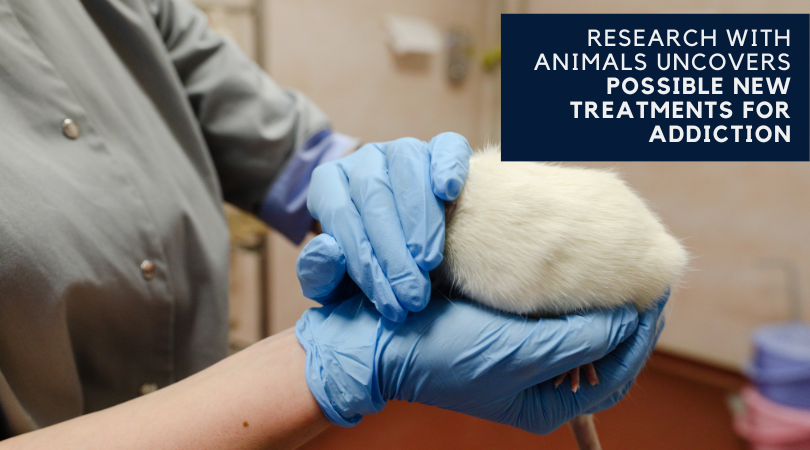Research with Animals Uncovers Possible New Treatments for Addiction
Posted on
Addiction is a complex condition with both physical and psychological causes and effects, which, coupled with the wide variation in addictive substances, makes it difficult to treat effectively. New research with mice and rats has uncovered potential new treatments that effectively reduce addictive behavior with no side effects.
Ozempic as an Addiction Cure
Ozempic, originally designed to enable type 2 diabetics to stabilize their insulin and blood sugar levels, is all the rage as a weight-loss drug, but researchers may have found another use for it: addiction treatment.

Ozempic contains semaglutide, which acts as a glucagon-like peptide-1 (GLP-1), blunting the “rewarding” effects of dopamine so people feel less pleasure from food, thus helping them lose weight. But people taking Ozempic have noticed that not only were they less interested in food, they also felt fewer cravings for nicotine, alcohol, and coffee.
To investigate this effect, researchers at the University of Pennsylvania tested GLP-1 in mice models of cocaine use disorder to determine if it could be used to reduce cravings for the drug. The team found that GLP-1 helped regulate addiction behavior in the mice by reducing their dopamine response to the drug.
Another study by a team of researchers from the National Institutes of Health and the Scripps Research Institute found that semaglutide reduces binge-like alcohol drinking in rats.
These and similar studies have raised hope that semaglutide and other GLP-1 drugs may hold promise as addiction treatments in humans.
Gene Editing Reverses the Effects of Anxiety and Alcoholism
Long-term substance abuse changes brain chemistry, leading to dependence, anxiety, and depression. A new study out of the University of Illinois may have found a way to reverse those changes.
Working with rats, the research team targeted the ARC (activity-regulated cytoskeleton) gene, which is suppressed in chronic alcohol users. Using the gene-editing tool CRISPR Cas9, the team increased ARC expression to reverse the muting effects of long-term alcohol use.
Rats were given alcohol during their “adolescent” years, which caused anxiety and increased alcohol consumption once they reached adulthood. They were then injected with CRISPR Cas9, and within two weeks both the levels of anxiety in the rats and their desire for alcohol decreased.
If the method is effective in humans, it could be used as a treatment for alcoholism in people exposed to binge drinking in adolescence.
A New Drug for Cannabis Addiction
According to the latest research from the Centers for Disease Control and Prevention, 48.2 million people, or about 18% of Americans, used cannabis at least once in 2019, and 3 in 10 people who use marijuana have cannabis addiction or cannabis use disorder.
To date, there is no treatment for cannabis addiction, but a team of researchers in France has developed a new drug that acts as an inhibitor of the cannabinoid receptor 1 (CB1) in the brain.
The drug, called AEF0117, works by preventing THC (tetrahydrocannabinol), the main psychoactive compound in cannabis, from binding to CB1. The drug has been tested in both animals and humans.
In animals (mice and non-human primates), AEF0117 reduced the self-administration of cannabis with no side effects or withdrawal symptoms. The drug had similar results in human volunteers in phase 1 and 2a trials, raising the hope that it could become a safe, successful treatment for cannabis addiction.
A Heart Medication Shows Promise for Addiction Treatment
Spironolactone, a medication used to treat heart problems and high blood pressure, may also be effective for treating alcohol use disorder, according to new research from the National Institutes of Health.
The drug works by blocking mineralocorticoid receptors, which are known to regulate fluid and electrolyte balance in the body. Previous research has shown that higher mineralocorticoid receptor signaling can cause higher alcohol consumption.
In mouse and rat models of alcohol use disorder, administering spironolactone to the animals decreased their alcohol consumption while leaving their food and water intake unaffected. The researchers also examined the medical records of people who had been prescribed spironolactone for its approved indications and found a significant decline in self-reported alcohol usage.
There are three FDA-approved drugs for the treatment of alcohol use disorder: disulfiram, naltrexone, and acamprosate. While all are effective to varying degrees, the addition of spironolactone could expand treatment options.